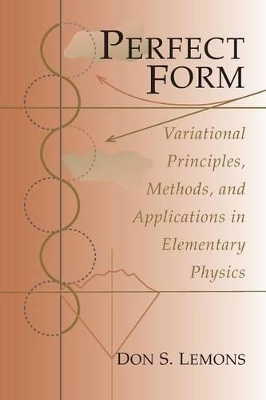
Perfect Form
Variational Principles, Methods, and Applications in Elementary Physics
Seiten
1997
Princeton University Press (Verlag)
978-0-691-02663-3 (ISBN)
Princeton University Press (Verlag)
978-0-691-02663-3 (ISBN)
- Lieferbar (Termin unbekannt)
- Versandkostenfrei innerhalb Deutschlands
- Auch auf Rechnung
- Verfügbarkeit in der Filiale vor Ort prüfen
- Artikel merken
Introduces the basic 'variational' principles of classical physics, develops the mathematical language suited to their application, and presents applications from the physics encountered in introductory course sequences. This book is designed to supplement classical mechanics texts and to present variational principles and methods to students.
What does the path taken by a ray of light share with the trajectory of a thrown baseball and the curve of a wheat stalk bending in the breeze? Each is the subject of a different study yet all are optimal shapes; light rays minimize travel time while a thrown baseball minimizes action. All natural curves and shapes, and many artificial ones, manifest such "perfect form" because physical principles can be expressed as a statement requiring some important physical quantity to be mathematically maximum, minimum, or stationary. Perfect Form introduces the basic "variational" principles of classical physics (least time, least potential energy, least action, and Hamilton's principle), develops the mathematical language most suited to their application (the calculus of variations), and presents applications from the physics usually encountered in introductory course sequences. The text gradually unfolds the physics and mathematics. While other treatments postulate Hamilton's principle and deduce all results from it, Perfect Form begins with the most plausible and restricted variational principles and develops more powerful ones through generalization.
One selection of text and problems even constitutes a non-calculus of variations introduction to variational methods, while the mathematics more generally employed extends only to solving simple ordinary differential equations. Perfect Form is designed to supplement existing classical mechanics texts and to present variational principles and methods to students who approach the subject for the first time.
What does the path taken by a ray of light share with the trajectory of a thrown baseball and the curve of a wheat stalk bending in the breeze? Each is the subject of a different study yet all are optimal shapes; light rays minimize travel time while a thrown baseball minimizes action. All natural curves and shapes, and many artificial ones, manifest such "perfect form" because physical principles can be expressed as a statement requiring some important physical quantity to be mathematically maximum, minimum, or stationary. Perfect Form introduces the basic "variational" principles of classical physics (least time, least potential energy, least action, and Hamilton's principle), develops the mathematical language most suited to their application (the calculus of variations), and presents applications from the physics usually encountered in introductory course sequences. The text gradually unfolds the physics and mathematics. While other treatments postulate Hamilton's principle and deduce all results from it, Perfect Form begins with the most plausible and restricted variational principles and develops more powerful ones through generalization.
One selection of text and problems even constitutes a non-calculus of variations introduction to variational methods, while the mathematics more generally employed extends only to solving simple ordinary differential equations. Perfect Form is designed to supplement existing classical mechanics texts and to present variational principles and methods to students who approach the subject for the first time.
Don S. Lemons is Associate Professor of Physics at Bethel College of North Newton, Kansas.
PrefaceCh. 1Least Time3Ch. 2Calculus of Variations17Ch. 3Curved Light33Ch. 4Least Potential Energy45Ch. 5Least Action69Ch. 6Hamilton's Principle - Restricted81Ch. 7Hamilton's Principle - Extended95Index115
| Erscheint lt. Verlag | 23.3.1997 |
|---|---|
| Zusatzinfo | 39 line illus. |
| Verlagsort | New Jersey |
| Sprache | englisch |
| Maße | 152 x 235 mm |
| Gewicht | 170 g |
| Themenwelt | Naturwissenschaften ► Physik / Astronomie ► Mechanik |
| ISBN-10 | 0-691-02663-7 / 0691026637 |
| ISBN-13 | 978-0-691-02663-3 / 9780691026633 |
| Zustand | Neuware |
| Informationen gemäß Produktsicherheitsverordnung (GPSR) | |
| Haben Sie eine Frage zum Produkt? |
Mehr entdecken
aus dem Bereich
aus dem Bereich
Schulbuch Klassen 7/8 (G9)
Buch | Hardcover (2015)
Klett (Verlag)
31,50 €
Buch | Softcover (2004)
Cornelsen Verlag
25,99 €


